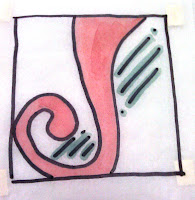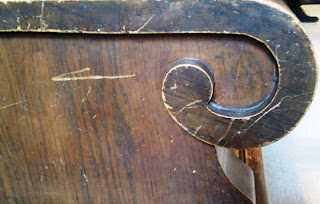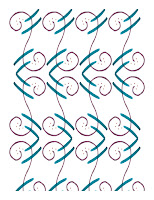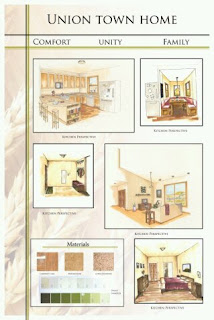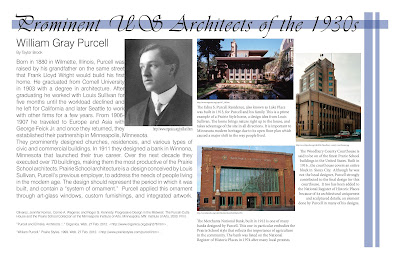Wednesday, April 18, 2012
Depot Project Concept Model
Textile Design
These pictures illustrate the process I went through to design my own textile for the Depot project we are currently working on. The first image is my inspiration object, the armrest of one of the original benches found in the Depot. From this picture I pulled three elements of design to continue my exploration: Contrast, Movement, and Rustic. With these three words I drew partis, small sketches, that I felt represented the combination of the words. My top eight are pictured. The next step was to choose my favorite two that I would turn into patterns. I rotated, flipped, mirrored, etc, to my parti modules to create different patterns. Two patterns for each module are shown. Once I created these patterns, I played around with various color schemes that I felt helped add to my concept with the three words. I focused mainly on complimentary colors to help add to the contrast. Once I chose my favorite pattern and color combination I created a 36"x36" pattern to represent what a yard of fabric, with that design, would look like. Using Spoonflower.com I uploaded my module, only to find my pattern was more complex then the few rotating options they had to offer. To fix this issue I simply uploaded the entire 36"x36" pattern onto Spoonflower's site and centered the pattern on the yard of fabric. After seeing how the fabric moved with the textile printed on it, I may have liked the pattern to have been smaller, but overall I'm very pleased with the final outcome, that is shown in the last image. I'm planning on incorporating the module in my Depot project by designing a coffee table that uses two modules side by side to create the legs.
Monday, March 26, 2012
Client Brief
For our adaptive reuse project, I have selected the artist Todd Horton to design a residence, studio, and gallery space. Todd is a painter who currently resides in Edison, WA. He grew up in an artistic family and spent many years traveling to countries like Japan, Germany, and parts of North Africa (along with many more) painting and teaching. The oil on canvas medium allows Todd to apply a quite distinctive effect that looks either "squeegeed" or "dripped." This gives the paintings a sense of movement. The two subjects he typically does are landscapes of the Pacific Northwest, and animals.
Because he resides in my hometown, I have visited Todd's studio, and one of the galleries he shows his work. Being able to walk through his studio and see how he works really helped me understand his process. It will allow me to better meet his needs in this project. Knowing how his work is currently displayed helps me understand one way to focus on his paintings, but also inspires me to find new and creative ways. I'm excited to work alongside him to create a space that will inspire him.
Because he resides in my hometown, I have visited Todd's studio, and one of the galleries he shows his work. Being able to walk through his studio and see how he works really helped me understand his process. It will allow me to better meet his needs in this project. Knowing how his work is currently displayed helps me understand one way to focus on his paintings, but also inspires me to find new and creative ways. I'm excited to work alongside him to create a space that will inspire him.
Dark Sky Blurred
36"x36"
Oil on Canvas
Eagles that Drift Like Dreams
36"x36"
Oil on Canvas
Field of Dew
30"x30"
Oil on Canvas
Running Water
20"x20"
Oil on Canvas
You can find more of Todd's work at www.toddjhorton.com as well as a full biography.
Tuesday, March 20, 2012
Habitat for Humanity
The first project of our Spring semester was one I took a personal liking to. We were given the opportunity to work with Habitat for Humanity here in the Palouse to design their next home. Although there wasn't a specific family chosen yet, we were given guidelines to help design the home. We were to design a 3 bedroom, 2 bath home in 1100 square feet. An open floor plan with a combined kitchen and living space was preferred. Budget was a large focus due to the need to keep the cost of the home low. We were also to keep mind sustainability and aging in place.
 With all this in mind, my partner Liz and I worked to create a space any family could truly enjoy. We worked hard on finding a floor plan that was different from the floor plan of the previous year's Habitat House, to add to the specialness of the home the family would receive. To do this we placed the kitchen/living space in the center of the floor plan. The master bedroom is located on one side of this space, and the children's bedrooms and laundry room are on the other. This allows for a separation between the parent's and children's spaces while creating a combined living space in between. This floor plan arrangement is driven by the quote "Home is where the heart is." The heart of our home design is the family area.
With all this in mind, my partner Liz and I worked to create a space any family could truly enjoy. We worked hard on finding a floor plan that was different from the floor plan of the previous year's Habitat House, to add to the specialness of the home the family would receive. To do this we placed the kitchen/living space in the center of the floor plan. The master bedroom is located on one side of this space, and the children's bedrooms and laundry room are on the other. This allows for a separation between the parent's and children's spaces while creating a combined living space in between. This floor plan arrangement is driven by the quote "Home is where the heart is." The heart of our home design is the family area.
Because there was not a family chosen by the time we did the project we decided to base our material choice on costs and sustainability. We chose to use a cork flooring, which we found for $2.98 a square foot, in the kitchen to help with sustainability. The entryway, utility room, and bathrooms use a marmoleum flooring that was around $3 a square foot. This material is more sustainable than vinyl, and is more durable than linoleum. The rest of the home uses a laminate wood flooring to help lower costs. The kitchen counter uses granite tiles which were $5.93 a square foot. The tiles still give the luxurious look of granite, while providing a much lower price. Although the price is higher than laminate counter top, the use of granite will increase the resale value of the home. The home is painted using a neutral color, but we chose to use an earthy green accent to pull in the comforting green tones of the Palouse.
We had to design the roof for the home and build it on our model, which helped show how much the floor plan can affect the roof. After way too many hours and a floor full of scraps I finally got our roof line to work, and I couldn't be more proud. Our wish to include vaulted ceilings with clerestory windows in the living space proved much harder than I expected but added the roof interest the Habitat committee was looking for.
Overall, this project was a great learning experience for me. Being able to communicate with actual clients provided an experience I never expected to have at this stage in my schooling. I was much more attentive to detail, and even more concerned about the decisions I made. Having worked on the previous habitat home allowed me to bring actual experience into the project.
 With all this in mind, my partner Liz and I worked to create a space any family could truly enjoy. We worked hard on finding a floor plan that was different from the floor plan of the previous year's Habitat House, to add to the specialness of the home the family would receive. To do this we placed the kitchen/living space in the center of the floor plan. The master bedroom is located on one side of this space, and the children's bedrooms and laundry room are on the other. This allows for a separation between the parent's and children's spaces while creating a combined living space in between. This floor plan arrangement is driven by the quote "Home is where the heart is." The heart of our home design is the family area.
With all this in mind, my partner Liz and I worked to create a space any family could truly enjoy. We worked hard on finding a floor plan that was different from the floor plan of the previous year's Habitat House, to add to the specialness of the home the family would receive. To do this we placed the kitchen/living space in the center of the floor plan. The master bedroom is located on one side of this space, and the children's bedrooms and laundry room are on the other. This allows for a separation between the parent's and children's spaces while creating a combined living space in between. This floor plan arrangement is driven by the quote "Home is where the heart is." The heart of our home design is the family area.Because there was not a family chosen by the time we did the project we decided to base our material choice on costs and sustainability. We chose to use a cork flooring, which we found for $2.98 a square foot, in the kitchen to help with sustainability. The entryway, utility room, and bathrooms use a marmoleum flooring that was around $3 a square foot. This material is more sustainable than vinyl, and is more durable than linoleum. The rest of the home uses a laminate wood flooring to help lower costs. The kitchen counter uses granite tiles which were $5.93 a square foot. The tiles still give the luxurious look of granite, while providing a much lower price. Although the price is higher than laminate counter top, the use of granite will increase the resale value of the home. The home is painted using a neutral color, but we chose to use an earthy green accent to pull in the comforting green tones of the Palouse.
We had to design the roof for the home and build it on our model, which helped show how much the floor plan can affect the roof. After way too many hours and a floor full of scraps I finally got our roof line to work, and I couldn't be more proud. Our wish to include vaulted ceilings with clerestory windows in the living space proved much harder than I expected but added the roof interest the Habitat committee was looking for.
Overall, this project was a great learning experience for me. Being able to communicate with actual clients provided an experience I never expected to have at this stage in my schooling. I was much more attentive to detail, and even more concerned about the decisions I made. Having worked on the previous habitat home allowed me to bring actual experience into the project.
Sunday, March 4, 2012
Context Poster
To get started on our next project for our Studio, the class was split into different groups and assigned a topic relating to either early 1900 design, or design for an art studio. My topic was prominent US architects of the 1930s, and I chose to research William Gray Purcell. I had no idea who he was, but his named kept popping up when I was searching. I learned a lot about Prairie Style design, a very common design type of the early 1900s. It was developed by Louis Sullivan, who taught Purcell, and was carried out by many architects including Frank Lloyd Wright, and Purcell himself. This style is reflected in the depot we are rehabilitating, so learning its origins and other ways it was applied was very helpful.
Subscribe to:
Posts (Atom)

